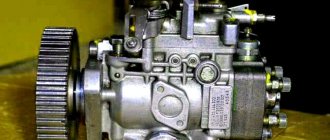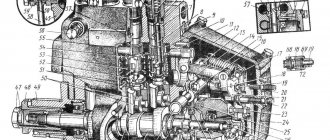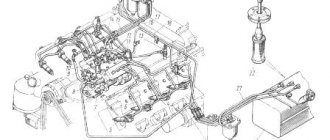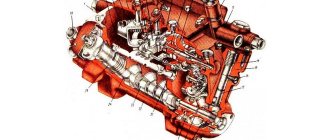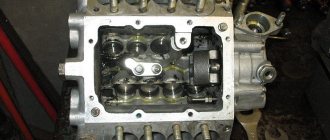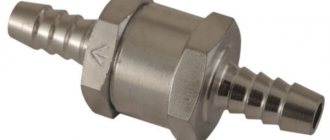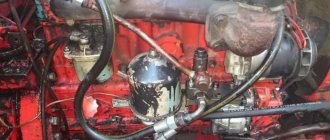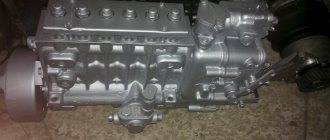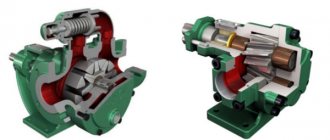The need for adjustment arises very often among drivers of KamAZ Euro 2, Euro 3. For example, the fuel injection pump drive plates broke in the field, so what should I do? I ran for the plates, changed them, and then I had to use regular keys without stroboscopes and other special equipment, not just to leave, but to continue working. How can this be done in the field? Everything will be described in simple and understandable language, but for now a little theory...
Many happy owners of diesel vehicles are accustomed to calling the “injection moment” “ignition”, as on a gasoline engine, but this is not important, the main thing is to understand the meaning of the process. Injection timing
- this is the start of fuel supply when the piston approaches top dead center with the intake and exhaust valves closed.
It turns out that the piston has compressed the air as much as possible, and at this moment fuel must be supplied. In general, why configure it? Why don’t they deliver it from the factory once and for all, so that we don’t suffer? It's simple! Each engine has its own injection timing, there are no absolutely identical units and components, and the fuel can also differ trivially - winter and summer diesel fuel. For this purpose, we are given the opportunity to adjust it, although absolutely every engine has MARKS or DEGREES... If the ignition is set exactly according to the marks, the car will of course work perfectly, but if it is a reference engine, a reference injection pump, and GOST fuel. The mark is a kind of guideline from which we must proceed, otherwise we would not have the opportunity to twist and turn in search of the best. On KamAZ, the injection pump drive itself is placed on a key on the side of the box, but the injection pump coupling can be rotated in two versions with a difference of 180 degrees. So, usually, when the drive clamping screw is on top, then the mark on the injection pump and on the coupling should be opposite each other. In short, we put everything on the marks, tightened it and you can start it. The car should start, but if it doesn’t start and there is white smoke coming out of the exhaust, it means you have misplaced it 180 degrees. We unscrewed it, turned it 180, tightened it and now we can start it for sure. If there are no marks, or there are an incomprehensible number of them previously filled in, then they should be placed approximately in the middle of the adjustment slots. After starting the car, you need to understand how the engine should work, what is it, that very “moment”? To understand this, you need to know the signs of a LATE and EARLY moment.
Types of fuel pumps
First, let's look at the types of fuel pumps for diesel cars, since each of them has its own characteristics and typical fuel injection pump malfunctions. So, knowing what type of pump it is, you can better understand the principle of operation and the immediate cause of the breakdown. Regardless of the type of high-pressure pump, you need to understand that the main unit is the so-called plunger pair - a piston (plunger) and a cylinder (bushing).
There are two main types of injection pumps:
- with direct action and mechanical action of the plunger;
- with battery injection.
However, high-pressure fuel pumps are still divided into classes according to their design. In particular:
- Rows . As the name implies, their working sections are arranged in one row, and fuel is supplied to each cylinder in turn.
- Distribution . With such pumps, one section can supply fuel to several different cylinders. Such devices can be single- or double-plunger.
- Multi-sectional . Another name for them is V-shaped or hydraulic accumulators. They are used for highly powerful, but low-speed engines. They are quite rare.
With direct injection fuel pumps, pumping and injection occur simultaneously. The mechanical drive of the plunger is responsible for this. With battery pumps, fuel is supplied in separate cycles, first it enters the pump accumulator, and only then into the injectors. The most modern systems are controlled electronically and are called Common Rail. They work based on information from numerous sensors located in different parts of the car.
Another injection system is a pump injector. In this case, they are combined into one mechanism. This system simplifies pressure control and also increases reliability, because if one injector fails, the engine will continue to operate, albeit with less power.
High-pressure fuel pumps were also invented for gasoline engines. They are used in engines with direct fuel injection. The pump's job is to supply gasoline under high pressure into the cylinders, where the fuel is directly mixed with the air mass, forming a mixture that is ignited by the spark plug.
Install the ignition on KamAZ
We will answer the question posed using the KamAZ 740 as an example. To do this, we will describe the ignition procedure of the KamAZ 740, which is similar to many models of this class.
Installation of the KamAZ 740 ignition is carried out in several stages:
- getting started we'll start by raising the truck cab
- we will fix the cabin on supports to protect the person’s work
- find the flywheel on which you will find the rod, it is located on the back of the flywheel on the top left side.
- lift the rod and rotate it ninety degrees, then return it to its original place
- find two bolts on the flywheel housing, unscrew them, you will need a seventeen mm wrench.
- To continue working, remove the mudguard
- through the slotted passage of the casing into the flywheel we insert a hard alloy rod 400 mm long and 10 mm in diameter
- perform rotational movements with the crankshaft until movement is blocked
- if the injection pump coupling is located with the scale up, you need to ensure that two marks coincide: zero with the mark on the fuel pump flange, secure with two bolts
- if the part is positioned in the opposite direction, lift the stopper and rotate the crankshaft one 360 degrees. After this, repeat the steps described above.
Signs of fuel injection pump malfunction
Despite the fact that high-pressure pumps belong to different types, the signs of their partial failure are typical and in many ways common to all. So, symptoms of a fuel injection pump malfunction include:
- increased fuel consumption in all engine operating modes;
- unstable operation of the engine, especially at low speeds;
- difficulty starting the engine, most often in the cold season;
- drop in engine power and dynamic characteristics of the machine as a whole;
- increase in engine exhaust smoke;
- fuel leak from the high pressure pump;
- the appearance of an oil emulsion in the engine coolant;
- increased engine noise.
Please note that the symptoms listed above may be signs of failure of other parts of the car's engine, such as the cooling system. Therefore, the condition of the high pressure pump must be diagnosed separately.
Experienced car enthusiasts identify another sign of a faulty high-pressure pump plunger. It lies in the fact that when the engine is hot, it may stall when idling. And at the same time, it will be almost impossible to start it until the pump itself cools down. “When cold,” the engine starts without problems.
Is the injection angle adjusted correctly?
It is necessary to check the correct ignition settings by turning the engine on and off. If there are signs of incorrect engine operation, you must repeat the described steps until the desired result is obtained. Correct installation is indicated by the absence of extraneous noise and the speed at which the motor starts. You can verify correct operation by using the idle speed. The rotation speed should be 600 rpm. Do not forget about safety precautions while working. Make sure the fuel supply system is turned off and you have secured the vehicle.
What could be better for you and your car?! And the increase in your truck's fuel consumption will be felt quickly, the moment you make a quick visit to the gas station and pay the check. Keep an eye on the health of your iron “friend”!
source
How to understand that everything is done correctly
The SZ must be adjusted correctly, otherwise the engine will run poorly. After the operations, it is turned on and checked. If signs of incorrect combustion appear, all manipulations are continued until a characteristic ringing sound appears when the gas lever is actively pressed. With a little cranking it goes away. This indicates that an accurate result is obtained. Correctly setting the injection point allows you to increase traction and reduce fuel consumption.
How do you regulate the ignition on your KamAZ?
When it is necessary to adjust injection
At the factory there is a special machine for adjusting the injection pump. Therefore, it works well without adjustments. But, there are times when, after some repair work, you have to adjust the injection angle, for example:
- After replacing the timing belt
- You removed the fuel injection pump, and you cannot install its pulley according to the special marks.
- Any other unavoidable repair work that disrupts the injection angle adjustment.
Let me remind you, dear readers, that to fully adjust the fuel injection pump you need a special stand. Therefore, disassembling it into parts or turning all the screws on it is simply stupid. You will misadjust the device so much that later, without a stand, you will no longer be able to adjust the operation of the motor back. Therefore, if you don’t understand what and why to turn, do not touch the pump’s full load screw and other screws, because you will not be able to adjust them back. You don't need extra problems and expenses, do you?
Useful tips
You can regulate the ignition on a diesel engine in the following ways:
- Adjustment by marks, if any.
- Selection of injection experimentally.
The main causes of fuel injection pump malfunction
The following are the causes of high pressure pump failure. Typically, the following structural elements fail:
- Plungers . Most often they are to blame, since the plunger pairs quickly become dirty. This is due to two reasons. The first is design features that provide a small gap that ensures high pressure in the system. The second is the low quality of diesel fuel, in particular, the presence of sulfur and paraffins in it, which, in fact, pollute the device. Dirt can also come from the engine (carbon deposits, dirt). Wear of the plungers leads to unstable engine operation at idle, increased fuel consumption, and decreased compression. Due to damage to the plunger pair, the bearings can significantly overheat.
- Water in diesel fuel . Also, domestic diesel fuel often has a high water content. Moisture washes away the fuel (at the same time protective) film from the surfaces of fuel injection pump parts, which causes the service life of precision parts to be significantly reduced. This may even cause the pump to jam.
- Dirty fuel filter . Due to a clogged fuel filter, the high-pressure pump, firstly, can become dirty (plunger pairs), and secondly, it wears out, which reduces its overall service life.
- Uneven supply and distribution of injected diesel fuel . This problem can also be caused by a malfunction of the plunger pairs, in particular, wear of the drivers, rack teeth, discharge valves, as well as dirty nozzles.
- Manufacturing defect . This situation is quite rare, but sometimes occurs on cheap pumps. Defects include cracks on the fuel injection pump housing, damage to its bearings, as well as jamming of the plunger bushing.
- Bearing wear . They usually wear out due to a critical decrease in service life (aging). Another option is a manufacturing defect. All this leads to the fact that the operating characteristics of the pump deteriorate, and the bearings and adjacent parts overheat, thereby reducing their service life.
- Piston and bushing jamming . This is a critical failure that can lead to breakage of the rack, cam shaft, gear, governor, keys. Often the cause of jamming is water getting into the cavity between the piston and the bushing.
- Wear of pump parts . This can occur both for natural reasons (with an increase in the mileage of the car) and when water gets inside it. It washes away the protective (working) lubricant from the elements, which significantly reduces both the service life of the pump as a whole and its individual parts.
- Corrosion of the plunger pair . Rusting spots may appear due to the increased water content in diesel fuel.
- Incorrect operation of the cooling system . That is, under prolonged and/or heavy loads, the high-pressure pump may simply overheat. The cooling system can be faulty for various reasons - low level of antifreeze or antifreeze, system clogging, breakdown of individual elements (pump, pipes, radiator, etc.).
- Depressurization of the system . This can happen not only if the high-pressure pump seals are damaged, but also other sealing elements. In any case, if the fuel injection pump becomes depressurized, it will operate under increased load, which will not only reduce its service life, but will also lead to the described breakdowns.
- Incorrect operation of the injection advance valve . This unit is installed on modern Common Rail diesel systems in order to increase engine efficiency and reduce fuel consumption. In turn, said advance valve is controlled by a corresponding solenoid valve of the high pressure pump. The system is controlled by the ECU, which commands a plunger that opens the valve mechanism. This way the pressure in the system is regulated.
- Broken plunger return spring . If the spring breaks in one place, then this will be a partial failure, and the section will operate, but with low efficiency. If the spring breaks in several places, then most likely the section will fail completely. In some cases, there is a decrease in the spring stiffness of the discharge valve. In this case, it is advisable to replace it.
If there is a suspicion that the fuel pump rack or associated parts are faulty, then you need to check for the presence/absence of the following defects:
- disconnecting the rack from the regulator parts;
- jamming or loosening of the clamps of the plunger leads;
- jamming of the coupling screws of the gear rims.
One of the most dangerous causes of a malfunction is a violation of the mobility of the fuel rail. In particular, if it jams at the moment of maximum fuel supply, and accordingly, the regulator does not have enough force to shift it to its original position, then an emergency increase in the number of crankshaft revolutions occurs in the engine, due to which the engine “goes into overdrive” all the ensuing consequences. If the rack is “bitten” while the gear is off, then in this case it will be impossible to start the engine at all. Partial jamming of the rack leads to unstable operation of the engine and an increase in its sound output (it begins to “growl”).
When using the machine in severe frost conditions, freezing of individual parts of the pump is sometimes observed, and its partial failure. To prevent this, it is necessary to use oils and diesel fuel with appropriate temperature ratings.
On common rail diesel systems, the control valve (or SCV flow valve) can fail. Usually it is replaced with a new one. Less often, they perform an audit and replace individual parts with new ones. In particular, the valve stem and core are often replaced.
Features of injection timing adjustment
What is the injection moment on KamAZ
The design of the ignition system of diesel trucks is somewhat different from their gasoline counterparts, where the task of igniting the mixture of gasoline and air is assigned to spark plugs. For a diesel engine, the term “injection timing” is more appropriate. In order for the power unit to start working, it is necessary to create high pressure in the chamber. After this, the fuel supply is turned on. The system begins to work when the piston approaches the top “dead” point.
If the system parameters are set incorrectly, engine parts may malfunction or overheat. It all depends on how the fuel mixture ignites - late or advanced.
Risks of untimely injection
- the engine becomes rough;
- when the accelerator is activated, a ringing sound occurs;
- the exhaust looks like white smoke;
- fuel consumption increases.
Late ignition is characterized by the flow of fuel when the piston leaves the upper position. In this case, the main signs of a malfunction are:
- a significant amount of whitish smoke from the exhaust pipe;
- decreased cravings;
- engine heating;
- increased fuel consumption;
- incorrect speed dial;
- vibration of the unit at medium speeds.
If any of the symptoms are observed, the KamAZ ignition must be adjusted as quickly as possible.
Adjustment procedure
On each engine you can notice special marks or degrees. They are intended to guide the driver who is solving the problem of how to set the ignition on a KamAZ.
In order for the engine to operate in normal mode, it is necessary that the characteristics of both the injection pump, the fuel, and the unit itself meet the requirements of the regulations. It is the marks that help determine how to set the ignition on a KamAZ correctly.
On the machines of the Kama plant, the pump that supplies fuel under high pressure is installed using a key on the side of the box. The pump coupling can be secured in two positions, the difference being 180 degrees. When the screw holding the drive is at the top, the marks of the injection pump and the pump coupling should be found opposite.
So, to check the ignition system, you need to:
- install the elements according to the marks;
- fix all elements;
- start the engine.
If the above malfunctions are observed, it means that the components are placed incorrectly and the operation should be repeated: loosen the elements, check the installation at 180 degrees, secure the components and start the engine.
The coordinated operation of the engine is important for the functioning of the vehicle as a whole: the KamAZ gearbox shafts will not be able to perform their task if problems are observed in the operation of the unit itself.
Shaft with cams
The shaft with cams transmits displacement to the plungers of the pump sections, diesel fuel is supplied to the chambers at the right time. The shaft is made of steel, the loaded surfaces are calcined with cement powder to 0.7-1.2 mm, rotation occurs through two bearings. The shaft is protected from leaks by a cuff, the material of the product is rubber. The front end of the shaft drives a clutch that sets the diesel injection angle. Rotating, the shaft transmits pressure to the pushers and then to the pump plungers through the heels. By changing the thickness of the heels, we influence the nature of the fuel supply; an increase in thickness provokes an early supply and vice versa.
How to determine fuel injection pump malfunctions
Please note that it is best to test the high pressure pump on professional stands specifically designed for this purpose. They allow you to find out the operating characteristics of the pump and other elements of the vehicle’s fuel system. However, such a check is only possible in a car service center, since such a stand is specialized and expensive equipment. In garage conditions, it is possible to carry out only a partial check of the fuel injection pump and determine only the main fault, while other possible faults will not be noticed!
Checking the presence of water in plunger pairs
To do this, you need to remove the timing belt and carefully twist the pulley. If it rotates with variable force, then everything is fine and there is no water in the pump. If rotation occurs under the influence of significant force and does not occur at all, then moisture is present. This is very harmful for both the pump and the engine as a whole, since the motor will work with increased effort when starting, until it completely jams (failure).
Checking the pressure in the plunger pair
There are special tools for this - testers, for example, KI-4802 or TAD-01A. If you don’t have such a tool at hand, you can use a pressure gauge with a high measurement range. So, it needs to be screwed into the seat of the fuel pipe, or into the central hole of the high pressure pump head. With a normal running engine, pressure readings should be approximately 300 kg/cm² and above (in fact, the corresponding value will vary for different brands of cars, as well as engine operating modes). If the fuel pressure is lower, it means that the plunger pair has worn out significantly and needs to be repaired or replaced (most often).
Control sensors
Modern common rail diesel systems that are controlled by an ECU (electronic control unit) tend to have problems with the sensors and/or their signal wiring. This often activates the Check Engine light on the dashboard. You need to use an error scanner to read their numbers and decipher them. Next, in accordance with the information received, make a decision on repairs.
Mostly the sensors fail (due to damage or old age), or problems arise with the wiring. For example, wires fray at the point of vibration and kinks, break, and their insulation value decreases. All this leads to the ECU receiving incorrect information from them, which leads to the formation of incorrect control signals.
Fuel leak
If diesel fuel flows from the fuel injection pump, then most likely the reason for this is the wear of its sealing rings. For diagnostics, it is necessary to shake the axis of the pump lever with the engine running . If the O-ring is damaged, diesel fuel will leak from underneath it. Sometimes leakage occurs from the installation sites of the plunger pairs. In this case, it is necessary to diagnose them. To do this, the high-pressure pump is usually dismantled.
To check the tightness of the injection pump shut-off valve, you must perform the following steps:
- unscrew the high pressure pipe from the faulty section;
- set the pressure pump rack to the off-feed position;
- Using a manual booster pump, artificially create excess pressure in the fuel system.
If the valve is faulty, fuel will flow through the pressure fitting hole . Otherwise the valve is OK.
Grasping the rack
To check the rack for sticking, you must first disconnect the rods from the regulator lever, as well as the stop bracket. Next, using the pump control levers, you need to move the rack to its extreme position. Accordingly, while the rack is moving, you can understand whether it is “stuck” or not. It is also advisable to rotate the cam shaft several times. Ideally, the rack should move smoothly and without jerking.
You can also see the movement of the rack with your own eyes, but this requires certain dismantling work. Most motors require the pump cover to be removed. For YaMZ engines, you need to unscrew the limiter housing or plug.
Pump freezing
If a fuel injection pump malfunctions in winter, you can check whether it has frozen. If the pump is frozen, it must be dismantled and brought into a warm room. Next, wait until it warms up and the mobility of the slats is restored. Next, the pump needs to be disassembled, the oil drained and washed with clean diesel fuel. After this, you need to pour new oil into the crankcase and install it back on the engine. And when this happens in particularly severe frosts, they also use a diesel fuel defroster to defrost the entire fuel line.
Using the stand
In a car service center, technicians use special diagnostic stands to check the operation of the high-pressure pump. In particular, the first thing people pay attention to is the performance of the pump. The operation of the plunger and control valve (SCV flow valve) is also checked.
The system is connected to the shaft position sensor so that the controller “sees” what position the injection is in, as well as to the fuel portion control valve. Next, the stand is put into operation and a certain number of cycles (several hundred) are counted. As a result of pump operation, a certain amount of fuel flows from the injectors into pre-prepared beakers, according to which one can judge the performance of both each of them and the fuel portion control valve.
In some cases, technicians replace the control valve with a known good one in order to determine the actual condition of the plunger pair.
We adjust the injection experimentally
Injection adjustment is made experimentally after installing the pulley. After installing the pulley, start the engine. If it does not start, then rotate the injection pump pulley relative to the timing belt by 2-4 teeth.
Start the engine again.
After the manipulations we have performed, it should start, listen to the operation of the motor. Obvious knocking sounds mean detonation; you need to turn the pump pulley in the direction 1-2 teeth opposite to its rotation. Thick gray smoke means late injection, then the pump pulley must be turned 1 tooth in the direction of its rotation.
If there are no changes for the better in the operation of the diesel engine, you need to rotate the pump around the axis. With such rotations it is necessary to achieve optimal operation of the unit. The best setting option would be to work in the mode before detonation knocks appear. They are very audible when the diesel engine is running.
The second method of the experimental method involves the following steps:
We unscrew the tube that goes from the pump to the injector on the first cylinder. Pull a transparent hose onto the removed end of the tube and place it in a vertical position.
Now you need to turn on the ignition and slightly turn the injection pump pulley. Rotate the pulley little by little, slowly and very carefully. At the same time, monitor the fuel level in the transparent hose. Determine the highest limit. When the diesel level is at the upper limit, make a mark on the pump pulley.
After this, the camshaft and crankshafts are set according to the marks. Start the engine and check its operation. If there are signs of improper injection, repeat the adjustment procedure again. If it still doesn’t work out, contact the service station, they will fix everything and, if necessary, adjust it at the stand.
That's all, friends, until we meet again, subscribe to the site update, if you haven't yet, share the link with your friends, if you haven't done so yet, there will be a lot more useful stuff.
Types, purpose and principle of operation of injection pump
As already mentioned, without a fuel pump, the operation of a diesel power plant is not possible. In engines of this type, the unit is entrusted with the task of dosing diesel fuel and supplying it to the combustion chamber at the right time. In addition, the pressure with which the portion is delivered is also important. The requirements complicate the work algorithm and force us to operate under increased load conditions.
Fuel injection pump YAZDA 337.20 for KamAZ:
KamAZ power plants, with an environmental class corresponding to Euro 2, use high-pressure pumps of several brands. Among manufacturers, the “lion’s” share falls on fuel injection pumps of the YAZDA series, used on KamAZ Euro 2. Products of the modification “337.20” are produced by a machine-building enterprise located in the city of Yaroslavl. The product is popular and accessible primarily due to its pricing policy. In addition, reliability and simplicity make the pumps less demanding, and balances the disadvantage associated with the accuracy of fuel dosage. Second place goes to the imported Bosch injection pump, installed on KamAZ of Euro 2 standard. The product is distinguished by its quality and accuracy, but there are often complaints about the pump drive, which does not withstand operating conditions.
Injection pump repair
Troubleshooting methods for a high-pressure fuel pump depend on the type of device, as well as the cause of the breakdown. We list the most common repair measures.
Replacing the plunger pair with your own hands
Before performing an independent check (without using a special stand), you must have handyman tools and a new plunger pair on hand, as well as have experience in performing repair work. We will describe the description of checking the condition of the high-pressure fuel pump using the example of a common Bosch injection pump.
It is necessary to understand that dismantling the pump depends on the specific model and even the car engine, so the procedure will be described in general terms. So, to replace a plunger pair (the most common type of repair) you need to:
- remove the terminals from the car battery;
- disconnect all wires and hoses suitable for it from the high-pressure pump;
- dismantle parts that prevent its removal from the car;
- unscrew the fasteners and dismantle the pump;
- carefully disassemble the pump, it is important not to lose small parts, and also remember the disassembly sequence (you can photograph this process step by step on your phone);
- unscrew and remove the plunger from the pump;
- clean all pump parts from dirt (you can use special carb cleaners or similar cleaners for this);
- check the rollers, bearings and racks on the pump; they should not show significant wear;
- remove the valves and the so-called “silencer” from the old plunger pair, and then install them on the new pair;
- Carry out installation work in reverse order.
Please note that replacing the plunger pair can only be done if you are completely sure that this unit is partially out of order, since it costs a lot of money.
Rack jamming
If you find that the rack is sticking, then the first thing to do is to find the place where it is “sticking”. This can be done by pumping up the ring gear relative to the rack in the corresponding section. If the rack does not jam, then there will be a small gap.
In this case, independent repair is hardly possible. However, in any case, it is necessary to dismantle the pump and show it to a specialist!
Preventive measures
As you know, prevention is the best repair, therefore, to save money and ensure normal engine operation, it is advisable to carry out simple preventive measures that will help extend the life of the high-pressure fuel pump. In particular:
- flushing the fuel system should be performed approximately once or twice a year;
- be sure to change the fuel filter on time (it is not advisable to clean it, because small particles of dirt will most likely remain on the filter);
- use high-quality fuel (at any gas station there is documentation indicating how long ago the fuel was delivered, as well as information about its composition, tolerances and seasonality );
- in winter, it is important to use winter diesel fuel, or to lower the freezing point (increase fluidity) of diesel fuel, you can use special compounds - antigels;
- it is advisable to leave the car for long periods of time (especially in cold weather) with a full tank, since moisture condensation forms on the inner walls of the tank overnight, which flows down and mixes with the fuel; instead, you can use the moisture removers mentioned above;
- do not allow the fuel level in the tank to drop critically;
- in winter, it is imperative to warm up the engine for several minutes before driving, taking into account the coolant temperature and oil pressure gauge readings;
- use special lubricating additives for diesel fuel if there is a suspicion of low quality diesel fuel.
The measures listed above will contribute to the normal operation of not only the high-pressure pump, but also the entire fuel system of the car as a whole.
The KamAZ injection pump is a mechanism designed to supply fuel fluid to the cylindrical mechanisms of the engine.
Design and principle of operation
The fuel injection pump device includes such mechanisms as:
- pump compartment housing;
- high pressure fuel pump bearing cover housing;
- inflation hose;
- plunger pair and plunger pusher;
- spring elements;
- mode selection regulator and coarse and fine filters;
- fitting for the fuel drain and injection system;
- fuel injection regulator;
- pressure reducing valve;
- an electromagnetic valve, which is necessary to shut off the fuel supply;
- rack, nozzle and coupling half.
The operating principle of the injection pump is as follows:
- Movement is set from the crankshaft mechanism using a mechanical transmission.
- The rotation of the cam shaft begins. This rotation provokes displacement of the pusher elements.
- The pushers begin to compress special springs.
- The springs cause the plunger to start working and lift it.
- The plunger closes the intake valve and displaces fuel fluid.
- The fuel begins to be sprayed using nozzles.
- The plunger lowers and opens the intake mechanism.
Where is the check valve located?
The check valve allows fuel to flow in only one direction - from the fuel tank to the engine. When the engine is turned off, it blocks unused fuel from draining back into the fuel tank. Do not confuse a check valve with a pressure reducing valve, which regulates the fuel pressure when supplied to the injectors; in the event of a malfunction of the valve, the fuel would be supplied without pressure, which makes it impossible for it to move further into the engine.
The check valve is located on the fuel rail between the fuel tank and the injectors. This arrangement allows, in addition to the main functions, to regulate the pressure at the injection pump inlet. On KamAZ models intended for operation in Arctic conditions, the OK is located in front of the heating system.
Pump departments
The pump section dispenses and supplies diesel fuel to the nozzles. Each unit includes a frame, a plunger pair, a rotation sleeve, elastic elements of the plunger, a discharge valve and a pusher.
Important How to choose a suitable walk-behind tractor for plowing a plot of land: tips, video
The frame is equipped with a flange that secures the section to the pump using studs. The pin holes are oval in shape; it is possible to adjust the uniformity of diesel supply to each compartment individually (turning clockwise reduces the supply, and vice versa). The plunger pair is directly involved in cutting off and transporting diesel fuel and consists of a sleeve and a plunger. The parts are precision made, the material is steel with the addition of chromium and molybdenum, followed by hardening and cooling with nitrogen. The plunger acts as a piston, has axial drilling and radial grooves that change the flow of diesel fuel. The precision pair of discharge valve and seat are made of steel, after the elements are hardened and cooled. Replacement of components is possible only as an assembly.
KamAZ injection pump cam shaft:
Bosch KamAZ Euro-3 injection pump: design and adjustment
The German fuel injection pump for KamAZ Euro-3 is a common component of new models. However, Bosch pumps break down more often. The fact is that operating conditions for trucks in Russia are very different from German ones, so many owners replace Bosch fuel injection pumps with YAZDA (Yaroslavl plant). The latter are inferior in the accuracy of measuring portions of incoming fuel, but are better suited for use on local roads.
The design of the Bosch KamAZ Euro-3 fuel injection pump is not fundamentally different from Euro-2 or domestic fuel injection pumps.
For proper operation, regular diagnostics of the injection pump and adjustment are necessary, which is necessary in the following cases:
- Increased fuel consumption
- No fuel supply to the injector
- Noises in the pump
Bosch KamAZ Euro-2 injection pump: design and adjustment
Bosch Euro-2 injection pump consists of:
- Frame
- Injection advance clutch
- All-mode regulator
- Plungers
- Booster pump
- Shaft
- Springs
- Valves
Bosch injection pump control can be mechanical or electronic; Euro-2 is often equipped with electronic control.
Most often, breakdowns occur during long-term operation; plungers and pumps wear out. Due to these breakdowns, fuel is supplied in larger quantities or not supplied at all.
In order to prevent damage to the fuel injection pump, it is necessary to remove sediment from the coarse filter daily and change the fine filters several times a year. If the injection pump breaks down, it is better to contact a specialist.
Disassembly procedure
- Unscrew the screws securing the rear cover of the speed controller and remove the cover assembled with the low-pressure pump;
- remove the automatic fuel injection advance clutch using tool I-801.16.000. First, unscrew nut 2 (Fig. a) securing the coupling. To do this, insert screwdriver 4 into the groove of the nut and, holding clutch 1 from rotating, use wrench 3 to unscrew the nut. Then, screwing puller 5 into the coupling (Fig. b), remove the coupling;
Fig. 2 – Removing the coupling
- unseal and unscrew the screws securing the protective casings of the injection pump sections and remove the casing;
- Unseal and unscrew the bolts securing the top cover of the regulator and remove the cover;
- take out the axis of the regulator lever and remove the regulator lever with the weight clutch lever, clutch, regulator spring and spring lever;
- remove the retaining ring and weight holder assembly;
- unscrew the rack plugs, remove the rack bushings, then the racks themselves, having previously unlatched them;
- unscrew the nuts securing the injection pump sections, remove the lock washers of the section fittings and remove the injection pump sections and plunger pushers;
- unscrew and unscrew the nuts and, using a puller I-801.26.000, remove the eccentric of the low-pressure pump drive, the drive gear of the regulator and the intermediate gear;
- remove the second bearing from the idler gear axis;
- knock out the keys from the toe and shank of the cam shaft, remove the rear bearing cover, remove the cam shaft assembly with bearings and remove the front bearing cover;
- using the puller I-801.30.000, remove the bearings from the cam shaft;
- Disassemble the fuel injection pump sections and the low-pressure fuel priming pump using tool I-801.20.000. To press out the discharge valve of the fuel injection pump section, use tool I-801.21.000.
Malfunctions and repairs
You can repair KamAZ fuel injection pump yourself if you have the necessary tools and equipment.
Main fuel injection pump malfunctions and reasons for their occurrence:
- Water in the fuel mechanism. This breakdown may indicate a malfunction of the fuel filter element, diluted fuel, or a leak in the fuel drives.
- Reduced and uneven supply of working fluid. In this case, it is recommended to check the plunger for damage, and also inspect the discharge valves and rack clamps. The capacity of the injectors should be checked.
- The diesel fuel is running out. The cause of this breakdown may be a leak in the fuel drive. The damaged element should be replaced.
- The drive is tearing. It is recommended to inspect the crankshaft, as well as the main components of the power unit for damage and foreign bodies.
- Delay of the working fluid injection system. Such a malfunction can be caused by damage to the plane of the adjusting bolt of the pusher element, the roller axis and failures in the rotation speed of the cam shaft.
How to remove and disassemble
Removal from engine:
- Remove the terminal from the battery.
- Remove the radiator.
- Remove the vacuum pump.
- Remove the oil dipstick guide pipe.
- Remove the oil filter filter mechanism.
- Turn the crankshaft in the direction of rotation until it stops.
- Disconnect fuel drives.
- Remove the vacuum hose.
- Block the crankshaft from turning.
- Unscrew the bolt in the center of the coupling.
- Remove the chain tensioner.
- Pull out the pump by dismantling the fuel pedal drive.
Disassembling the KamAZ fuel injection pump is done as follows:
- It is necessary to remove the metering type valve from the end of the pump housing. To do this, you need to unscrew the bolts of the pressure plate and release the advance valves of the injection system.
- Then you should remove the fastenings on the top cover.
- You need to disassemble the control board to gain access to the electronics.
- It is necessary to set the required position of the crankshaft.
- Then you need to dismantle the bearing using special equipment.
- At the end, all parts should be washed and their surface polished.
Adjusting the pneumatic corrector
The function of the KamAZ 740 injection pump pneumatic corrector is to regulate the fuel supply. When the air flow pressure decreases, the amount of fuel supplied is reduced, which prevents overheating and smoking of the engine. Also, the operation of such equipment affects engine oil consumption: if everything is in order, then oil consumption is uniform.
Adjusting the pneumatic corrector allows you to change the amount of fuel entering the injectors. The whole process is very simple, does not have a complex sequence of actions and can be easily done with your own hands. The pneumatic corrector is adjusted by two bolts:
The first is responsible for spring tension and is located coaxially with the spool. The corrector operates at increased pressure, which means it is necessary to increase the spring tension by tightening the bolt.
The second screw is responsible for the direct supply of fuel; unwinding it will increase the volume of incoming fuel.
On the Internet you can find pictures and videos showing step-by-step adjustment of the corrector. Fuel supply corrector circuit:
How to add or reduce fuel
Adjusting the Bosch injection pump on KamAZ makes it possible to add fuel, i.e. set the required fuel supply value.
Procedure for reducing fuel:
- Using a key of 13, you need to adjust the air flow to the mechanisms of the power unit. Thanks to this, diesel will be able to mix with air.
- Make adjustments to the corrector and start the motor for testing.
- If necessary, you need to further tighten the air flow until the smoke stops coming out.
In order to add fuel to the KamAZ injection pump (Euro-2 or Euro-3), you need to do the following:
- Tighten the special screws that are located in the upper and side parts of the working fluid supply.
- When unscrewing the bolts, you need to increase the gap for the passage of the combustible mixture. This will help normalize the performance of the power unit and the lubrication system of the high-pressure fuel pump.
- Having increased the diameter of the hole, you should start the engine and check the operation of all systems.
How to install correctly
Installation (installation) of the fuel pump must be carried out using special equipment.
In order to correctly supply and install a high-pressure fuel pump on a KamAZ truck, do the following:
- The vehicle is installed on a special platform.
- Mount the driven clutch onto the advance clutch and secure everything with bolts.
- Turn the coupling so that the bosses of the driven type coupling half are in a horizontal position, and the mark on the end part is in the pointer area.
- Install the flange assembly with the drive coupling half and plate packs. The flange should be located on the left side of the housing.
- Install the fuel pump along with the coupling onto the engine and secure everything with mounting bolts.
- Before tightening the bolts, adjust the flatness of the plate packs by moving the flange along the drive shaft.
- The pump is mounted on a block of cylindrical elements in a vertical position, preventing it from blocking.
- The injection pump sections are connected to the injectors.
- Adjust the advance angle of the injection system.
- Check the presence of oil fluid in the injection pump housing.
- Connect the oil inlet and outlet pipes.
AUTOMATIC CLUTCH
Automatic clutch
The automatic clutch is a centrifugal regulator. The drive shaft of the pump 1 is connected to the cam shaft of the fuel pump 16 not rigidly, but through a coupling 3 having the following device. At the end of the drive shaft 1 of the fuel pump (see Fig. 62), the driving coupling half 10 is secured. The driven coupling half 15 is secured with a key on the cam shaft of the pump. On two axes 13 of the driven coupling half 15, weights 11 are freely mounted. Springs 14 rest against the axles 13 with one end and the thrust pin 19 of the driving half of the coupling with the other. The drive shaft 1 of the fuel pump rotates in conjunction with the driving coupling half, which through the pins 19 presses on the inner curved surface loads 11. The weights through the axles 13 transmit rotational force to the driven coupling half 15
Automatic clutch
Rice. 42. Automatic fuel injection advance clutch: a - general view of the design; 6 - operation diagram; c - details;
1 — fuel pump drive shaft; 2 — drive flange of the pump drive shaft coupling half; 3 — drive flange fixing bolt; 4 - coupling bolt; 5 — pump drive shaft coupling half; 6 — washer of the pump drive shaft coupling half; 7 — coupling body; 8, 18 and 21 - oil seals; 9 — bushing of the driving coupling half; 10 — driving coupling half; 11- cargo; 12 — adjusting shims; 13 — load axis; 14 — load spring; 15 — driven coupling half; 16 - cam roller of the fuel pump; 17 — rubber ring; 19 — thrust pin of the drive half of the coupling; 20 - ring nut
As the number of revolutions of the crankshaft 7...increases, the weights 11, under the influence of centrifugal force, overcome the resistance of the springs 14 and diverge (position P), sliding their curved surface along the surface of the pins 19 of the drive half-coupling.
The distance between the axles 13 of the weights and the fingers 19 is reduced. As a result of this, the driven coupling half 15 rotates relative to the drive half at a certain angle. Pump cam shaft, rigidly connected to the coupling half
automatic clutch
As the engine speed decreases, the centrifugal force decreases, the weights converge, and the driven clutch rotates in the direction opposite to rotation.
The injection advance angle decreases. Operating in this way, the automatic clutch, when starting at any engine speed, provides injection advance angles close to optimal.
It is known that an excessive increase in engine speed is dangerous because the resulting forces can cause increased wear and even breakdown. Therefore, carburetor and diesel engines are equipped with a regulator that does not allow the speed to increase above the set speed.
WATCH THE VIDEO
